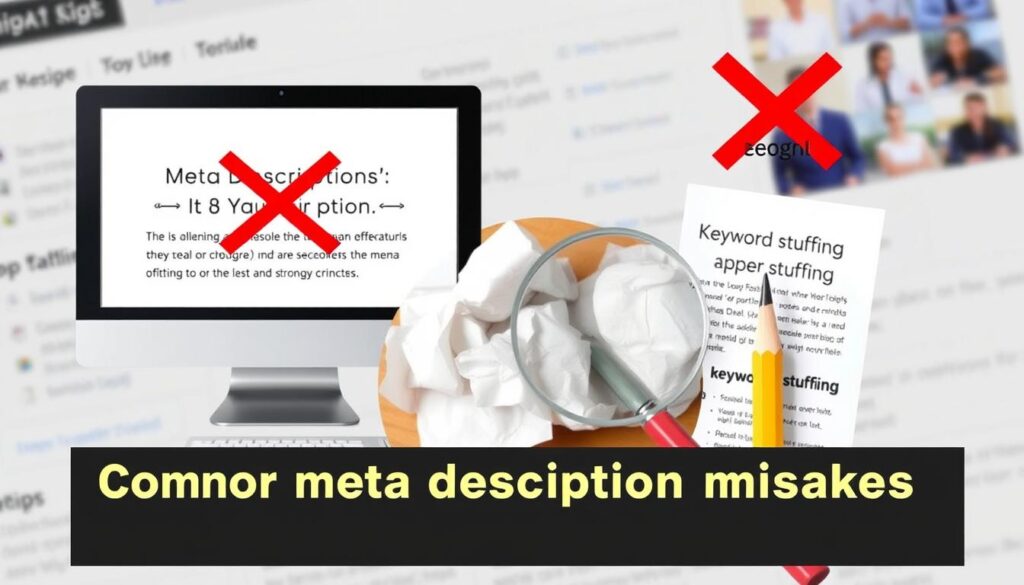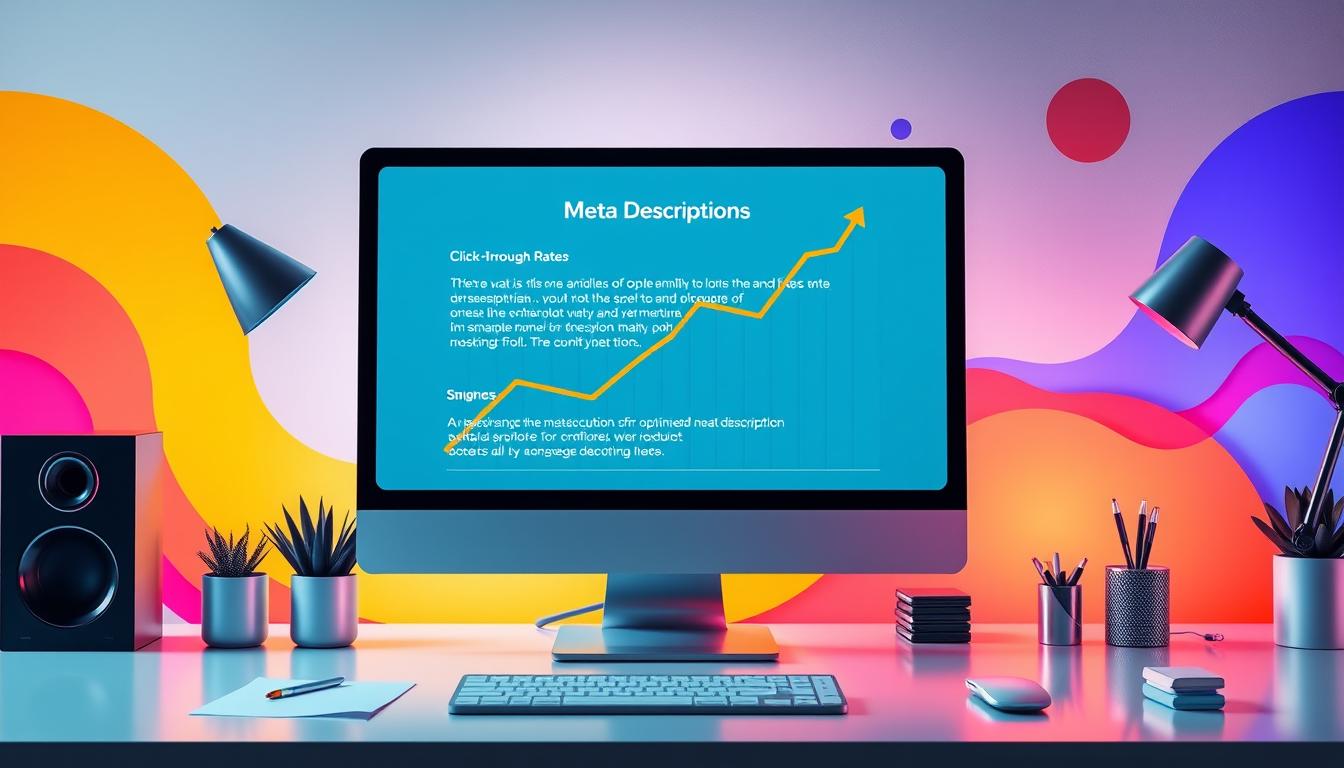Did you know that nearly 70% of marketers believe that meta descriptions are essential for driving traffic to their websites? While often overlooked, optimizing meta descriptions for higher CTR can significantly influence how your site is perceived in search engine results. By implementing meta description best practices, you can elevate your visibility and entice more users to click through to your content.
In this article, we will explore effective strategies for increasing click-through rate with meta descriptions. From understanding what a meta description is to identifying common mistakes to avoid, we’ll guide you through the essentials of crafting compelling descriptions that resonate with your audience.
Optimizing your meta descriptions is not just about filling characters; it’s about creating a powerful marketing tool that can shape user expectations and drive traffic. Dive in as we explore the critical elements that can transform your meta descriptions from mundane to magnetic.
Key Takeaways
- Meta descriptions are vital for attracting clicks in search results.
- Effective descriptions align with page content and include CTAs.
- A/B testing can reveal what resonates best with your audience.
- Avoid common mistakes like keyword stuffing and duplication.
- Use analytics to track performance and make informed adjustments.
Understanding Meta Descriptions and Their Importance
Meta descriptions encapsulate the essence of a webpage’s content, manifesting as concise summaries that precede the page title in search engine results. They offer a preview of the content’s nature, thereby influencing user anticipation. In the contemporary digital epoch, the creation of impactful meta descriptions is paramount, as they play a pivotal role in shaping user engagement.
What is a Meta Description?
A meta description, typically spanning 150 to 160 characters, encapsulates the essence of a webpage’s content. Its primary function is to entice users to explore the site further. The strategic inclusion of pertinent keywords within these summaries can elevate visibility and enhance engagement probabilities.
Why Meta Descriptions Matter for SEO
Although meta descriptions do not directly influence search rankings, their significance in augmenting click-through rates cannot be overstated. Compelling descriptions foster user engagement, which, in turn, can indirectly affect search rankings. Thus, the adoption of robust meta description optimization strategies is indispensable for achieving digital success. Implementing such strategies can markedly enhance your site’s online presence.
The Role of Meta Descriptions in CTR
An adeptly crafted meta description can significantly boost the click-through rate (CTR) by offering a clear and captivating preview of the webpage’s content. This engagement prompts users to click, thereby contributing to increased traffic and an enhanced user experience.
Elements of an Effective Meta Description
The creation of compelling meta descriptions holds a pivotal role in enhancing user engagement and driving traffic. By focusing on key elements, one can significantly improve meta tags for CTR. An effective meta description transcends mere summary; it functions as a marketing tool, designed to entice users to click on your link.
Key Components to Include
When crafting a meta description, it is imperative to incorporate the following essential components:
- Unique summary: Offer a brief overview of the page’s content.
- Target keywords: Include relevant keywords to boost visibility.
- Value proposition: Clearly communicate the benefits the user will gain.
These factors are critical in achieving CTR enhancement through meta tags.
The Importance of Length and Clarity
Aiming for a length between 150-160 characters ensures that your description displays wholly in search results without truncation. Clarity is paramount, with a focus on avoiding jargon to deliver your message effectively. Utilizing concise language can significantly aid in improving meta tags for CTR, making it easier for users to understand the value of your content.
Using Call-to-Actions (CTAs)
Including call-to-action phrases creates a sense of urgency and encourages interaction. Phrases such as “Learn more,” “Discover,” or “Get started” prompt users to take the next step. These small additions often lead to a noticeable improvement in CTR. Engaging CTAs promote user actions that can lead to higher conversions. For further insights on effective CTAs, refer to this resource.
Best Practices for Writing Meta Descriptions
The art of crafting meta descriptions necessitates a meticulous approach and a strategic mindset. Adherence to meta description best practices can markedly elevate your webpage’s visibility and click-through rate. Below, we outline pivotal strategies to consider.
Crafting Unique Descriptions for Each Page
Every webpage necessitates a bespoke meta description. Such uniqueness ensures content accuracy, thereby enhancing search query relevancy. A meticulously crafted description can entice potential visitors, drawn by the information’s appeal. It is imperative to eschew generic statements, instead emphasizing the unique aspects of each page.
Aligning Descriptions with Page Content
Ensuring the meta description’s congruence with the page’s content is paramount. This alignment fosters user expectations, potentially reducing bounce rates. Incorporating key themes and keywords from the content within the description optimizes search engine performance. Consistent messaging guarantees that users find their intended content upon arrival.
A/B Testing Your Meta Descriptions
A/B testing unveils the most effective meta description variations in attracting clicks. By experimenting with different wording and structures, valuable insights into audience preferences are gleaned. Leveraging data from these tests facilitates ongoing refinement, enhancing meta description optimization for search engines.
Keyword Optimization for Meta Descriptions
Optimizing meta descriptions with targeted keywords is paramount for enhancing visibility on search engine results pages. This strategic incorporation signals to both search engines and users that your content aligns with their queries. Such alignment is critical for improving your page’s relevance and click-through rates.
The Role of Target Keywords
Integrating target keywords into your meta descriptions significantly boosts your page’s relevance. These keywords must accurately reflect the primary focus of your content. This alignment assists search engines in matching your pages with users’ queries, thereby increasing the chances of higher rankings.
Balancing Keywords with Readability
While keyword optimization is crucial, maintaining readability is equally vital. Crafting descriptions that naturally engage users is essential. Overstuffing keywords can result in confusing language, deterring clicks. Strive for a balance that enhances both visibility and user experience, a key factor in optimizing meta descriptions for higher CTR.
The Impact of Meta Descriptions on User Experience
Meta descriptions are instrumental in shaping user experience within the realm of SEO. By crafting these descriptions with precision, one can observe a notable enhancement in click-through rates (CTR). It is imperative for content creators and webmasters to understand the profound impact of well-crafted meta descriptions on user engagement and overall satisfaction.
Enhancing Click-Through Rates
Engaging and informative meta descriptions have the potential to captivate interest, thereby boosting CTR. When descriptions accurately convey the content awaiting users on a webpage, they capture attention and stimulate clicks. This inclination towards engaging results is driven by a resonance with specific needs and interests.
Setting Correct Expectations for Visitors
Accurate meta descriptions are crucial in setting the right expectations for visitors. By clearly reflecting the content that awaits users on the landing page, trust is fostered. When the landing page meets the expectations set forth in the meta description, it significantly enhances user experience in SEO. This is achieved through reduced bounce rates and increased user satisfaction.
Common Mistakes to Avoid in Meta Descriptions

Grasping the nuances of meta description errors is pivotal for enhancing your website’s efficacy. Identifying and circumventing these errors is essential for optimizing meta descriptions to elevate CTR. Rectifying these mistakes fosters greater user engagement and ascends your site’s search rankings.
Overstuffing Keywords
The prevalent error of keyword overloading into a single meta description is a significant blunder. This approach not only diminishes clarity but also erodes user appeal. Cluttered descriptions, replete with terms, can tarnish your site’s reputation. It is imperative to maintain a natural flow while ensuring that relevant keywords are seamlessly integrated into the description.
Using Duplicates Across Pages
Employing identical meta descriptions across disparate pages confounds both visitors and search engines. Such duplication erodes CTR and impairs overall site SEO performance. It is imperative to craft unique descriptions, each tailored to the distinct content of each page. This meticulous approach guarantees that users are provided with accurate previews, enhancing their browsing experience.
Ignoring Mobile Users
In today’s digital epoch, overlooking mobile users is detrimental. With an increasing number of mobile searches, optimizing meta descriptions for mobile display is critical. It is essential to design concise, engaging content that might not be truncated. Emphasize the core of your content while ensuring visibility across all devices.
Tools and Resources for Optimizing Meta Descriptions
The optimization of meta descriptions is significantly facilitated by the employment of advanced tools and resources. These tools streamline the process of crafting impactful descriptions, thereby enhancing click-through rates. Below, we outline key strategies to augment your optimization efforts.
Content Management Systems and SEO Tools
The integration of content management systems (CMS) with specialized SEO tools is paramount. Platforms such as Yoast SEO and SEMrush are equipped with functionalities that streamline the optimization of meta descriptions. They offer insights into optimal length, keyword placement, and content performance analysis.
Analyzing Competitor Meta Descriptions
An examination of your competitors’ successful meta descriptions can yield substantial benefits. Identifying audience-resonating strategies and integrating them into your approach is crucial. By adopting elements that elevate your meta descriptions, you can aim to increase your click-through rates. Utilizing tools like Ahrefs allows you to dissect successful tactics and incorporate them into your content strategy.
For further insights, refer to the terms of use. A comprehensive understanding of various tools’ functionalities is essential for making informed decisions that drive effective optimization.
How to Evaluate Your Meta Descriptions

Assessing meta descriptions is imperative for comprehending their role in driving traffic. Through regular performance evaluations, one can pinpoint areas for enhancement, thereby augmenting online presence.
Monitoring Click-Through Rates (CTR)
For an accurate assessment of meta description efficacy, it is essential to periodically scrutinize CTRs via tools like Google Analytics. This methodology furnishes indispensable data, enabling the identification of descriptions that elicit clicks and those that require optimization. Descriptions with elevated CTRs signify effective user engagement, whereas those with diminished rates necessitate reevaluation. Continuous monitoring of trends is vital to gauge the sustained performance of your descriptions.
Using Analytics to Improve Performance
SEO performance analytics offer profound insights into user behavior, facilitating targeted modifications to meta descriptions. By dissecting engagement metrics, one can discern the elements that captivate the audience. The objective is to craft descriptions that emphasize the most captivating facets of your content. This alignment with audience preferences aims to elevate CTRs and overall visibility.
Real-World Examples of Effective Meta Descriptions
An examination of successful brands unveils the intricacies of crafting compelling meta descriptions. Entities such as HubSpot and Moz exemplify the art of engaging and strategic meta description crafting. These exemplars demonstrate the pivotal role effective meta descriptions play in elevating click-through rates (CTR).
Successful Brands and Their Strategies
HubSpot’s meta descriptions are characterized by their concise yet impactful phrasing, ensuring a precise alignment with the content’s essence. Their adeptness in encapsulating key benefits within the confines of character limits attracts a considerable audience. In parallel, Moz’s approach centers on the creation of transparent and informative descriptions, designed to entice users to engage. Both entities epitomize exemplary brand strategies for optimizing CTR, predicated on a profound understanding of their audience’s preferences and interests.
Lessons Learned from High-Performing Descriptions
Case studies offer invaluable insights into the crafting of effective meta descriptions. Successful descriptions exhibit several common traits:
- Effective length: Optimal descriptions span between 150-160 characters, ensuring maximum visibility on search engine results pages (SERPs).
- Engaging wording: Selecting action-oriented language stimulates user engagement.
- Clear calls-to-action: Encouraging users to explore further or initiate action significantly enhances CTR.
Adopting these strategies is paramount in enhancing overall performance, thereby driving site traffic and engagement.
Staying Updated with Meta Description Trends
In the rapidly evolving digital marketing landscape, the imperative to stay abreast of SEO transformations is paramount for sustaining a robust online footprint. The adaptation to meta description SEO trends is crucial for augmenting visibility and aligning with the shifting user preferences.
Keeping Up with SEO Changes
Engaging in a continuous review of algorithmic updates and industry news empowers marketers with the requisite knowledge to refine their meta description strategies. This awareness enables businesses to ensure their methodologies remain pertinent and effective, thereby enhancing their SEO performance.
Adjusting Strategies Based on User Behavior
An ongoing analysis of user engagement patterns unveils invaluable insights into audience preferences. By implementing optimizing strategies for user engagement, marketers can craft meta descriptions that resonate with user interests, thereby boosting click-through rates. Observing trends in user behavior facilitates adjustments that elevate relevance and effectiveness.
Conclusion: Mastering Meta Descriptions for Success
The art of crafting meta descriptions is paramount for elevating your website’s visibility and click-through rates. By creating descriptions that are both optimized and user-centric, you not only bolster your SEO standing but also provide clarity to potential visitors regarding the content they will encounter upon clicking. Adherence to best practices, such as employing unique, captivating phrases and compelling call-to-actions, while steering clear of common errors, is crucial for achieving substantial outcomes.
The dynamic nature of SEO demands an unwavering dedication to refining your strategies continuously. Regularly revising and evaluating your meta descriptions in light of shifting user preferences is imperative for maintaining a competitive edge. For a more comprehensive grasp of optimizing these elements, delve into this resource on mastering SEO techniques.
View the enhancement of your meta descriptions as a perpetual endeavor. Prioritizing flexibility and responsiveness will not only enhance engagement but also fortify your digital footprint. Seize this opportunity to refine your tactics, and witness tangible improvements in your site’s performance, propelling you towards your SEO objectives.
